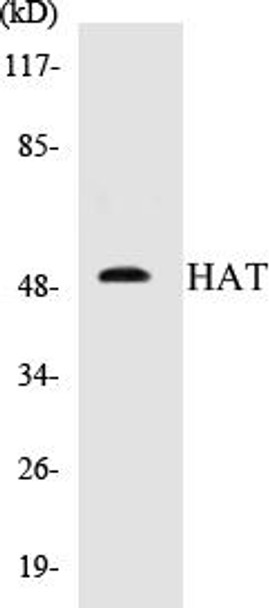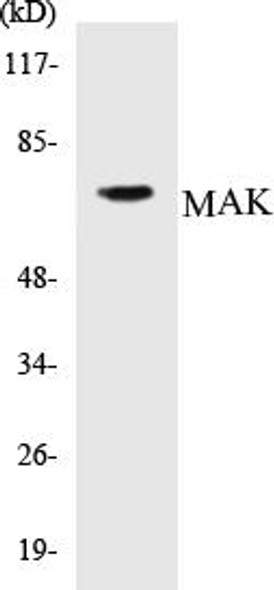Description
HAT Colorimetric Cell-Based ELISA Kit
The Hat Colorimetric Cell-Based ELISA Kit is a cutting-edge assay designed for the accurate measurement of a specific protein in human samples. This kit boasts high sensitivity and specificity, allowing for precise and reproducible results across various research applications.The protein targeted by this kit plays a vital role in various physiological processes, including angiogenesis and cell proliferation. Its dysregulation has been linked to serious health conditions such as cancer, cardiovascular diseases, and neurodegenerative disorders, making it a crucial biomarker for understanding and potentially treating these diseases.
With the Hat Colorimetric Cell-Based ELISA Kit, researchers can confidently quantify this important protein in serum, plasma, and cell culture supernatants, enabling detailed studies that can lead to new insights and therapeutic strategies. Trust in this comprehensive kit for robust, reliable data that drives impactful research progress.
| Product Name: | HAT Colorimetric Cell-Based ELISA |
| Product Code: | CBCAB00308 |
| ELISA Type: | Cell-Based |
| Target: | HAT |
| Reactivity: | Human, Mouse, Rat |
| Dynamic Range: | > 5000 Cells |
| Detection Method: | Colorimetric 450 nmStorage/Stability:4°C/6 Months |
| Format: | 96-Well Microplate |
The HAT Colorimetric Cell-Based ELISA Kit is a convenient, lysate-free, high throughput and sensitive assay kit that can detect HAT protein expression profile in cells. The kit can be used for measuring the relative amounts of HAT in cultured cells as well as screening for the effects that various treatments, inhibitors (ie siRNA or chemicals), or activators have on HAT.
Qualitative determination of HAT concentration is achieved by an indirect ELISA format. In essence, HAT is captured by HAT-specific primary antibodies while the HRP-conjugated secondary antibodies bind the Fc region of the primary antibody. Through this binding, the HRP enzyme conjugated to the secondary antibody can catalyze a colorimetric reaction upon substrate addition. Due to the qualitative nature of the Cell-Based ELISA, multiple normalization methods are needed:
| 1. | A monoclonal antibody specific for human GAPDH is included to serve as an internal positive control in normalizing the target absorbance values. |
| 2. | Following the colorimetric measurement of HRP activity via substrate addition, the Crystal Violet whole-cell staining method may be used to determine cell density. After staining, the results can be analysed by normalizing the absorbance values to cell amounts, by which the plating difference can be adjusted. |
| Database Information: | Gene ID: 8520, UniProt ID: O14929, OMIM: 603053, Unigene: Hs.632532 |
| Gene Symbol: | HAT1 |
| Sub Type: | None |
| UniProt Protein Function: | HAT1: Acetylates soluble but not nucleosomal histone H4 at 'Lys-5' (H4K5ac) and 'Lys-12' (H4K12ac) and, to a lesser extent, acetylates histone H2A at 'Lys-5' (H2AK5ac). Has intrinsic substrate specificity that modifies lysine in recognition sequence GXGKXG. May be involved in nucleosome assembly during DNA replication and repair as part of the histone H3.1 and H3.3 complexes. May play a role in DNA repair in response to free radical damage. Belongs to the HAT1 family. 2 isoforms of the human protein are produced by alternative splicing. |
| UniProt Protein Details: | Protein type:Acetyltransferase; EC 2.3.1.48 Chromosomal Location of Human Ortholog: 2q31.2-q33.1 Cellular Component: intracellular membrane-bound organelle; nuclear chromatin; nuclear chromosome, telomeric region; nucleoplasm; nucleus; protein complex Molecular Function:H4 histone acetyltransferase activity; histone acetyltransferase activity; histone binding; protein binding Biological Process: DNA packaging; DNA replication-dependent nucleosome assembly; DNA replication-independent nucleosome assembly; internal protein amino acid acetylation |
| NCBI Summary: | The protein encoded by this gene is a type B histone acetyltransferase (HAT) that is involved in the rapid acetylation of newly synthesized cytoplasmic histones, which are in turn imported into the nucleus for de novo deposition onto nascent DNA chains. Histone acetylation, particularly of histone H4, plays an important role in replication-dependent chromatin assembly. Specifically, this HAT can acetylate soluble but not nucleosomal histone H4 at lysines 5 and 12, and to a lesser degree, histone H2A at lysine 5. Alternatively spliced transcript variants have been identified for this gene. [provided by RefSeq, Jun 2009] |
| UniProt Code: | O14929 |
| NCBI GenInfo Identifier: | 3334209 |
| NCBI Gene ID: | 8520 |
| NCBI Accession: | O14929.1 |
| UniProt Secondary Accession: | O14929,Q49A44, Q53QF0, Q53SU4, Q6P594, Q8WWB9, |
| UniProt Related Accession: | O14929 |
| Molecular Weight: | 39,786 Da |
| NCBI Full Name: | Histone acetyltransferase type B catalytic subunit |
| NCBI Synonym Full Names: | histone acetyltransferase 1 |
| NCBI Official Symbol: | HAT1 |
| NCBI Official Synonym Symbols: | KAT1 |
| NCBI Protein Information: | histone acetyltransferase type B catalytic subunit |
| UniProt Protein Name: | Histone acetyltransferase type B catalytic subunit |
| UniProt Synonym Protein Names: | Histone acetyltransferase 1 |
| Protein Family: | HAT1-interacting factor |
| UniProt Gene Name: | HAT1 |
| UniProt Entry Name: | HAT1_HUMAN |
| Component | Quantity |
| 96-Well Cell Culture Clear-Bottom Microplate | 2 plates |
| 10X TBS | 24 mL |
| Quenching Buffer | 24 mL |
| Blocking Buffer | 50 mL |
| 15X Wash Buffer | 50 mL |
| Primary Antibody Diluent | 12 mL |
| 100x Anti-Phospho Target Antibody | 60 µL |
| 100x Anti-Target Antibody | 60 µL |
| Anti-GAPDH Antibody | 60 µL |
| HRP-Conjugated Anti-Rabbit IgG Antibody | 12 mL |
| HRP-Conjugated Anti-Mouse IgG Antibody | 12 mL |
| SDS Solution | 12 mL |
| Stop Solution | 24 mL |
| Ready-to-Use Substrate | 12 mL |
| Crystal Violet Solution | 12 mL |
| Adhesive Plate Seals | 2 seals |
The following materials and/or equipment are NOT provided in this kit but are necessary to successfully conduct the experiment:
- Microplate reader able to measure absorbance at 450 nm and/or 595 nm for Crystal Violet Cell Staining (Optional)
- Micropipettes with capability of measuring volumes ranging from 1 µL to 1 ml
- 37% formaldehyde (Sigma Cat# F-8775) or formaldehyde from other sources
- Squirt bottle, manifold dispenser, multichannel pipette reservoir or automated microplate washer
- Graph paper or computer software capable of generating or displaying logarithmic functions
- Absorbent papers or vacuum aspirator
- Test tubes or microfuge tubes capable of storing ≥1 ml
- Poly-L-Lysine (Sigma Cat# P4832 for suspension cells)
- Orbital shaker (optional)
- Deionized or sterile water
*Note: Protocols are specific to each batch/lot. For the correct instructions please follow the protocol included in your kit.
| Step | Procedure |
| 1. | Seed 200 µL of 20,000 adherent cells in culture medium in each well of a 96-well plate. The plates included in the kit are sterile and treated for cell culture. For suspension cells and loosely attached cells, coat the plates with 100 µL of 10 µg/ml Poly-L-Lysine (not included) to each well of a 96-well plate for 30 minutes at 37°C prior to adding cells. |
| 2. | Incubate the cells for overnight at 37°C, 5% CO2. |
| 3. | Treat the cells as desired. |
| 4. | Remove the cell culture medium and rinse with 200 µL of 1x TBS, twice. |
| 5. | Fix the cells by incubating with 100 µL of Fixing Solution for 20 minutes at room temperature. The 4% formaldehyde is used for adherent cells and 8% formaldehyde is used for suspension cells and loosely attached cells. |
| 6. | Remove the Fixing Solution and wash the plate 3 times with 200 µL 1x Wash Buffer for five minutes each time with gentle shaking on the orbital shaker. The plate can be stored at 4°C for a week. |
| 7. | Add 100 µL of Quenching Buffer and incubate for 20 minutes at room temperature. |
| 8. | Wash the plate 3 times with 1x Wash Buffer for 5 minutes each time. |
| 9. | Add 200 µL of Blocking Buffer and incubate for 1 hour at room temperature. |
| 10. | Wash 3 times with 200 µL of 1x Wash Buffer for 5 minutes each time. |
| 11. | Add 50 µL of 1x primary antibodies (Anti-HAT Antibody and/or Anti-GAPDH Antibody) to the corresponding wells, cover with Parafilm and incubate for 16 hours (overnight) at 4°C. If the target expression is known to be high, incubate for 2 hours at room temperature. |
| 12. | Wash 3 times with 200 µL of 1x Wash Buffer for 5 minutes each time. |
| 13. | Add 50 µL of 1x secondary antibodies (HRP-Conjugated AntiRabbit IgG Antibody or HRP-Conjugated Anti-Mouse IgG Antibody) to corresponding wells and incubate for 1.5 hours at room temperature. |
| 14. | Wash 3 times with 200 µL of 1x Wash Buffer for 5 minutes each time. |
| 15. | Add 50 µL of Ready-to-Use Substrate to each well and incubate for 30 minutes at room temperature in the dark. |
| 16. | Add 50 µL of Stop Solution to each well and read OD at 450 nm immediately using the microplate reader. |
(Additional Crystal Violet staining may be performed if desired – details of this may be found in the kit technical manual.)






